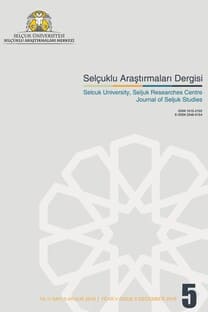MOĞOLLARIN RUS KNEZLİKLERİ İLE DOĞU VE ORTA AVRUPA TOPRAKLARINI İSTİLASI (1236-1242)
THE INVASION OF GRAND DUCHIES OF RUSSIA AND EASTERN AND CENTRAL EUROPEAN LANDS BY THE MONGOLS
___
- Abûl Farac, Gregory. (1987). Abû’l Farac Tarihi (C. II). (Doğrul, Ö. R. Çev.). Ankara: Türk Tarih Kurumu Yay.
- Anonim. (1986). Moğolların gizli tarihi I. tercüme (Temir, A. Çev.). Ankara: Türk Tarih Kurumu Yay.
- Apak, Â. (2014). Anahatlarıyla İslâm Tarihi (4) (Abbasiler Dönemi). İstanbul: Ensar Neşriyat.
- Atwood, C. P. (2004). Encyclopedia of Mongolia and the Mongol Empire. New York: Fact On File Inc.
- Bilgin, A. A. – Hacıeminoğlu, N. (2002). Kıpçaklar. İslâm Ansiklopedisi (C. 25, s. 421-424). Ankara: Türk Diyanet Vakfı Yay.
- Breschanider, E. (1888). Medieval researches From Eastern Asiatic Sources. London: Trubner & Co., Ludgate Hill.
- Chambers, J. (1979) The Devil’s horsemen the Mongol invansion of Europe. London: Book Club.
- Cheshire, H. T. (1926). The great Tartar invasion of Europe. The Slavonic Review, V/(13), 89- 105.
- Curta, F. (2019). Eastern Europe in the Middle ages (500–1300). Leiden: Brill.
- Curta, F. (2008). The other Europe in the Middle ages: Avars, Bulgars, Khazars and Cumans (East central and eastern Europe in the Middle ages, 450-1450). Leiden: Brill.
- Cüveynî, A. A. M. (2013). Tarih-i Cihan Güşa (Öztürk, M. Çev.). Ankara: Türk Tarih Kurumu Yay.
- d’Ohhson, A. K. (2008). Moğol Tarihi, denizler İmparatoru Cengiz (Apaydın, B. Çev.). İstanbul: Nesnel Yay.
- Engel, P. (2009). The realm of st. Stephan a history of Medieval Hungary, 895–1526 (Ayton, A. Trans.). London: I. B. Tauris Publishers.
- Fennell, J. (2014). The crisis of Medieval Russia 1200-1304. New York: Routledge.
- Dimnik, M. (2003). The Dynasty of Chernigov 1146-1246. New York: Cambridge University Press.
- Grigor, A. (2012). Okçu milletin Tarihi (Andreasyan, H. D. Çev.). İstanbul: Yeditepe Yay.
- Grousset, R. (1996). Bozkır İmparatorluğu, Atilla, Cengiz Han, Timur (Uzmen, M. R. Çev.). İstanbul: Ötüken Yay.
- Hemedanî, R. F. (1971). The Successors of Genghis Khan (Boyle, J. Trans.). New York and London: Columbia University Press.
- İbn Kesîr. (2000). el-Bidâye ve’n-Nihâye Büyük İslâm Tarihi (C. 7). (Keskin, M. Çev.). İstanbul: Çağrı Yay.
- Jackson, P. (2014). The Mongols and the West 1221-1410. New York: Taylor & Francis.
- Kafalı, M. (1993). Cuci Han. İslâm Ansiklopedisi (C. 8, s. 78-79). İstanbul: Türkiye Diyanet Vakfı Yay.
- Kennedy, H. (2002). Mongols, Huns & Vikings Nomads at war. London: Cassell&Co.
- Kiragos, G. (2018). Moğol istilası 1220-1265 (Mahmut Kemal Bey, Terc.). İstanbul: Post Yay.
- Konukçu, E. (1992). Berke Han. İslâm Ansiklopedisi (C. 5, s. 506-507). İstanbul: Türkiye Diyanet Vakfı Yay.
- MacArtney, C. A. (1940). Where was "Black Wallachia" in the thirteenth century?. The Journal of the Royal Asiatic Society of Great Britain and Ireland, 2, pp. 198-200.
- McDaniel, R. J. (2005). The Mongol invasions of the near east, San Jose State University. San Jose: Unpulished Dissertation’s Thesis.
- Muhammedoğlu, A. S. (1994). Derbend. İslâm Ansiklopedisi, (C. 9, s. 164-166). İstanbul: Türkiye Diyanet Vakfı Yay.
- Nesevî. (1934). Celâlüttin Harzemşah. (Asım, N. Trc.). İstanbul: Türk Tarih Kurumu Yay.
- Nossov, K. S. (2007). Medieval Russian Fortresses AD 862–1480. Oxford: Osprey Publishing.
- Özcan, A. T. (2010). Moğol-Rus İlişkileri (1223-1341) (Yayımlanmamış Doktora Tezi). Ege Üniversitesi, İzmir.
- Pow, S. - Liao, J. (2018). Subutai: sorting fact from fiction surrounding the Mongol Empire’s greatest general (with translations of Subutai’s two biographies in the Yuan Shi). Journal of Chinese Military History, 7, 37-76.
- Rachewilt-z, İ. D. (1993). In the service of the Khan eminent personalities of the early Mongol Yüan Period. Wiesbaden: Harrassowitz Verlag.
- Roux, J.P. (2006). Orta Asya Tarih ve Uygarlık (Arslan, L. Çev.). İstanbul: Kabalcı Yay.
- Rubruk, W. V. (2019). Moğolların Büyük Hanı’na seyehat 13. yüzyılda İstanbul’dan Karakutum’a Yolculuk (Ayan, E. Çev.). İstanbul: Kronik Kitabevi.
- Rudenko, K. A. (2014). The Mongol conquests and their reflection in material culture of the peoples of the Middle Volga and Kama regions (the 13th–early 14th centuries; according to the archaeological data). Golden Horde Review, IV/(4), 134-144.
- Rybatzki, V. (2006). Die personennamen und titel der Mittelmongolıschen dokumente eine lexikalische untersuchung. Helsinki: Yliopistopaino Oy.
- Sinor, D. (1999). The Mongols in West. Journal of Asian History, XXXIII/(1), 1-44.
- Slappy, S. (2010). Command And Control Began With Subotai Bahadur, The Thirteenth Century Mongol General (Unpublished Master’s Thesis). Marine Corps University, Virginia.
- Sverdrup, C. F. (2016). The Mongol conquests the military operation of Genghis Khan and Sübe’etei. England: Helion & Company Limited. The Hypatian Chronicle: The Galician–Volynian
- Chronicle (1973). (II/16) (Perfecky, G. A. Trans.). München: Willhelm Fin Verlag. The Nikonian Chronicle From the Year 1132-1240
- (Volume Two) (1984). (Zenkovsky S. A. - Zenkovsky B. J. Trans.). New Jersey: The Kingston Press.
- Turnbull, S. (2003). Genghis Khan & the Mongol Conquests 1190-1400. Oxford: Osprey Publishing.
- Vardan, M. (2017). Türk fetihleri Tarihi (889-1269) (Andreasyan, H. D. Çev.). İstanbul: Post Yay.
- Vernadsky, G. (1944). A history of Russia. New Haven: Yale University Press.
- Welsh, W. E. (2016). The Mongol devastation of Polond the battle of Legnica. Medieval Warfare, V/(6), 26-34.
- Zenkovsky, S. A. (1974). Medieval Russia’s epics, chronicles, and tales. New York: E. P. Dutton & Co., Inc.
- Zimonyi, I. (2019). Moğolların batı seferleri (Gezer, Ş. Çev.). Türk Tarihi Araştırmaları Dergisi, IV/(1), 419-452.
- ISSN: 1015-2105
- Yayın Aralığı: Yılda 2 Sayı
- Başlangıç: 1986
- Yayıncı: Selçuk Üniversitesi
ŞÂHNÂME’DE YER ALAN ZIRH, MİĞFER VE KALKAN İLE İLGİLİ KAYITLAR
ÂŞIK PAŞA’NIN GARÎB-NÂME ADLI ESERİNDE GEMİNİN FAALİYET VE İSTİKAMETİ İÇİN GEREKLİ SEKİZ UNSUR
KARAMANOĞLU MEHMET BEY’İN KONYA MUHASARASI VE SİYAVUŞ’UN KİMLİĞİ
YAZMA ESERLERDE VARAKLARA NUMARA ATAMA VE VARAK-SAYFA EŞLEŞTİRMESİ
MOĞOLLARIN RUS KNEZLİKLERİ İLE DOĞU VE ORTA AVRUPA TOPRAKLARINI İSTİLASI (1236-1242)
ṬABAḲĀT-I NAṢIRĪ'NİN BÜVEYHİLER BAŞLIĞININ DEĞERLENDİRİLMESİ
ORTA ÇAĞ ANADOLUSU'NDA KULLANILAN TIBBÎ BİTKİLERİN X. YÜZYILDAN XII. YÜZYILA KADAR TEDARİĞİ
SELÇUKLULAR DÖNEMİNDE İKTANIN GULAMLAR ÜZERİNDEKİ SOSYAL VE EKONOMİK ETKİSİ
II. HUGUES DE LUSİGNAN DÖNEMİNDE KIBRIS VE KUDÜS NAİPLİĞİ MESELESİ
MİRYOKEFALON SAVAŞINA GİDEN SÜREÇTE TÜRKMENLERİN SELÇUKLU-BİZANS İLİŞKİLERİNDEKİ ROLÜ
